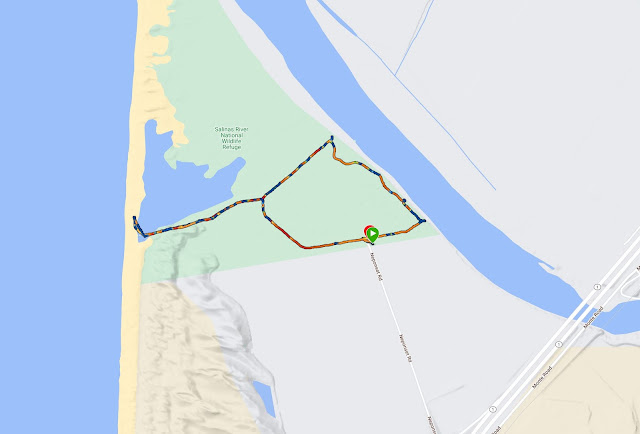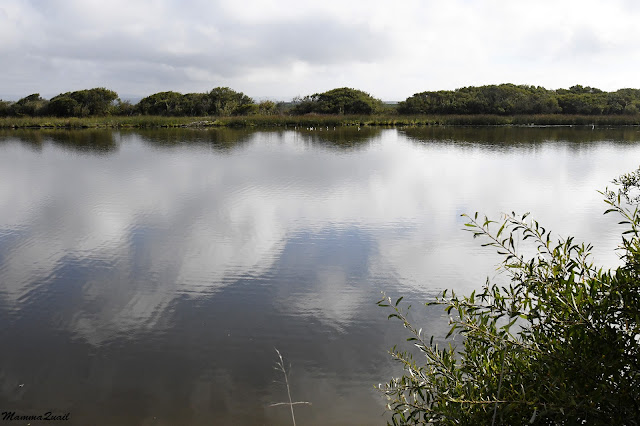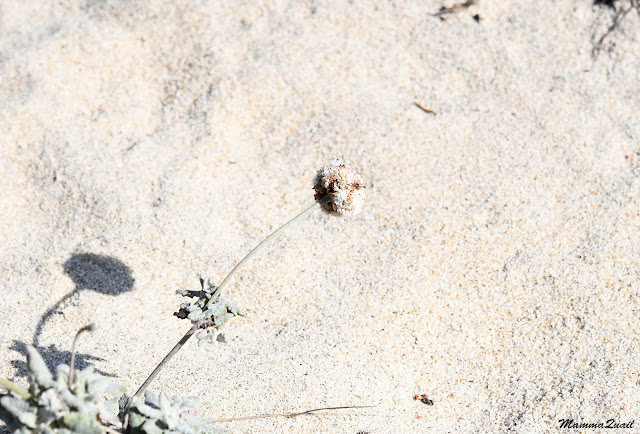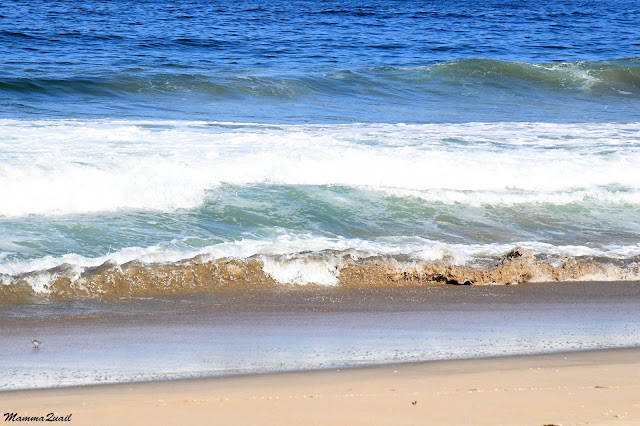 |
| Salinas River |
Date: September 4, 2023
Place: Don Edwards National Wildlife Refuge, Salinas River Unit
Place: Don Edwards National Wildlife Refuge, Salinas River Unit
Coordinates: 36.734849, -121.793873
Length: 2.1 miles
Level: easy
Nearly a decade ago we visited Monterey in a full family format, including Grandma Quail. The Salinas River unit of Don Edwards National Wildlife Refuge was one of the places we wanted to hike at, but we couldn't get in. The access road from Highway 1 is packed dirt and our visit then was during a fairly wet winter, meaning the road was deep mud. We left our car near the hwy 1pavement and tried walking in, but the mud was so deep and sticky that we soon gave up - it was too much for us, with the two little chikas along.
On our latest visit in the Monterey area we were only Pappa Quail and me, and it was the end of summer, and very dry indeed. On Labor Day, en-route home, we drove into the refuge without any issues, and went on the hike we had wanted to do for years.
 |
| At the trailhead |
The refuge is situated south of where the Salinas River spills into the ocean. Part of the trail is along the river itself, and part goes near a brackish water lagoon. It goes through high coastal scrub vegetation, and there's coastal access through the dunes. All and all, there are at least four different habitats in this fairly small refuge. We expected this habitat diversity to reflect in our sightings, and it sure did.
 |
| Our hike as captured by my GPS |
Birds were present right at the trailhead. Little, brown bush birds all of them. Pappa Quail can tell them apart, maybe one day I will, too.
 |
| House Finch |
The trail was a dirt road flanked by either tall bushes or areas of dry grassland. We didn't see much along the first part of the trail, but before long the trail curved to follow the path of the Salinas River. I knew that from looking at my navigator because a belt of thickly growing tall vegetation blocked the river from our view.
 |
| Trail |
As soon as we spotted a gap in the vegetation we stepped off the trail and walked over to check out the river. We couldn't get too close at first because although the low crowing vegetation wasn't blocking our view, it did block our access to the bank. We saw birds there, on the water, and wend back to the main trail hoping to find a place where the river was more approachable.
 |
| Salinas River |
That place was just a little further down the path.We walked all the way to the river bank and gazed on the river. A fallen log was stuck there long enough to have accumulated sediments and grow other plants. A number of birds were using it as a safe perch to rest upon - cormorants and gulls.
 |
| Double-crested Cormorants |
 |
| Salinas River |
There was a great egret wading in the shallows near the north bank of the river. I could barely see the white spot against the dark green tule, but Pappa Quail photographed it.
 |
| Great Egret |
 |
| Western Terrestrial Garter Snake |
Another gap in the vegetation further down the trail gave us a view on another log where a small group of black-necked stilt huddled together, at a safe distance from the gull and the cormorant that shared the log with them.
 |
| Black-necked Stilt |
Back on the trail we resumed our walk westward. I kept on the lookout for wildflowers, and I did see some, though not as many as I've seen the day before at Garrapata State Park.
 |
| Bull Thistle, Cirsium vulgare, non-native, invasive |
As in the previous hikes we did on this trip - the aster family dominated the end of summer bloom scene in both numbers, and number of species.
 |
| Western Goldenrod, Euthamia occidentalis |
Eventually the tall vegetation remained behind us and we got an open, wide view on the Salinas River, all the way to the ocean. Above us the sky was partly cloudy, which gave the surrounding a patchy illumination pattern. A large gray cloud was hanging over the ocean on the horizon, but the river looked blue and the far away dunes glowed in the sun.
 |
| Salinas River |
Another opening in the vegetation gave us another access to the river bank. On the river (now looking gray again) floated a flock of slender birds. I didn't need the zoom lens to identify these birds - their silhouette was telling enough - these were phalaropes.
 |
| Red-necked Phalaropes on the Salinas River |
The close-up photos that Pappa Quail took identified the species though - these birds were red-necked phalaropes. These birds are unusual in the sense that when wearing their mating colors the females looks fancier than the males.
 |
| Red-necked Phalarope |
We spent some time looking at the phalaropes swimming gracefully, occasionally dipping their beaks in the water to catch something and swallow it. Eventually we returned to the main trail and resumed our hike due west.
 | |
|
The trail curved sharply southwest and the river continued northwest toward the ocean. This stretch of trail was flanked by much lower vegetation and different wildflowers bloomed alongside it.
 |
| Gumplant, Grindelia stricta |
We started seeing butterflies too. Not in huge numbers like in spring time, but enough to give an air of spring to this late summer hike.
 |
| White Cabbage Butterfly |
Pappa Quail didn't pay attention to the butterflies. He had noticed the lagoon ahead of us, on the way to the beach.
 |
| Checkerspot Butterfly |
The lagoon wasn't connected to the river, not above ground, anyway. Even from afar we could see that there was a large group of birds huddled at the lagoon's inland side.
The trail leading to the lagoon was the beach access trail. When we begun the hike we didn't know if we'd go all the way to the beach. Now there was n doubt anymore. We left the lop trail and turned right on the beach access trail.
 |
| Beach Access Trail |
Pappa Quail hurried ahead. I lingered a bit behind, looking at the butterflies that were fluttering by. I encountered more butterfly species as I moved along the trail, including this beautiful swallowtail in the photo below.
 |
| Anise Swallowtail Butterfly |
The trail wasn't very close to the lagoon. There was a narrow path in the vegetation that connected the trail to the lagoon's shore but we didn't go there. We didn't want to disturb the birds.
 |
| Lagoon |
Pappa Quail could get good photos using the strongest zoom settings. Even from afar we could tell that most of the birds there were gulls, but only at maximal magnification the gull species could be identified.
One of the gulls was sitting apart from the rest, and although still far away, it was the closest to us. It looked young, and perhaps it was alone because of some infliction.
 |
| California Gull |
Apart from the gulls was a group of terns. Caspian terns, as identified through the maximal zoom. The terns stayed clear of the gulls, remaining in their own small and aloof clique.
 |
| Caspian Tern |
A line of dunes separated the lagoon and us from the beach. The dirt road came to an end and from the end of road sign extended a narrow foot path through a low gap in the dunes all the way to the beach. We got this far, so certainly we would go to the ocean now.
 |
| Beach Access Trail |
The dunes were all bound by vegetation, most of it coastal scrub. There were little birds active in the bushes and Pappa Quail focused on them.
 |
| White-crowned Sparrow |
At the base of the beach access trail grew a large, very lush green bush that looked familiar to me. I got near it to take a closer look, identified it, and kept safe distance from then on - it was poison oak. I'm not used to seeing poison oak as a thick mass like this. It is however, a competent plant shape-shifter that can assume many, many forms, even a thick massive bush on the dunes near the ocean beach.
 |
| Poison Oak, Toxicodendron diversilobum |
There were other familiar plants growing on the dunes, of species more expected to grow there as part of the coastal scrub community.
 |
| European Searocket, Cakile maritima, non-native, invasive |
I was in my element now. Many of the dune plants were blooming, and although most of them I've seen on our hikes the day before, I was still happy to see them again.
 |
| Mock Heather, Ericameria ericoides |
Curled around the mock heather bush was the yellow sand verbena, and it too, was blooming.
There were other wildflowers that I haven't seen earlier on this trip, such as the California golden poppy - the California state flower.
 |
| California Poppy, Eschscholzia californica |
The beach access trail is the shortest trail segment on this hike, yet it took me the longest to hike, and it's nt the sand that's to blame. It is very difficult for me to speed walk past so many cool plantlife, especially when so many of them were in bloom in a season that's expected to be a bloom downtime.
 |
| Coast Buckwheat, Eriogonum latifolium |
Perhaps the sand terrain is to blame after all, because this interesting plant community is special for coastal dunes. The few dudleyas that I saw there did surprise me. None were right by the trail so I had to ask Pappa Quail t photograph them for me. None of them were blooming either, but their leaf rosette is as beauitiful as a flower.
 |
| Dudleya sp. |
The last part of the beach access trail is adjacent to a small creek on the north, one that never reaches the ocean above ground. The presence of fresh water close to the surface was very apparent, however, even if `i didn't see the water directly. The vegetation along that tiny creek was clearly different from that growing on the dunes, closer to riparian vegetation.
On the south side f the trail the dune rose to its highest. Any blooming plants were visible only from a close distance. From a wider point of view the dune vegetation looked like it had transitioned to autumn already, which was abut the right time of year to do so.
 |
| Beach access trail |
We passed the last crest of the sand trail and the ocean view opened up before us. The dark cloud mass that we saw hanging over the water earlier on the hike was completely gone by the time we made it to the beach. The sky was clear and blue, and the Pacific Ocean wore shiny blue as well. There were shorebirds walking to and fro along the strand line, and Pappa Quail immediately got busy documenting them.
 |
| Pacific Ocean |
That it was very early autumn I could tell also by the low amount of kelp swept on the beach. Later in the fall California beaches get covered with drift kelp that piles up on the sand and rots there. The fall time aroma of California beaches is unmistakable and carries far inland as well. This decomposing algal biomass provides sustenance to many microorganisms, insects, and crustaceans. These small animals in turn, feed numerous larger crustaceans, insects, and birds. This way the kelp, is an essential component of the California coastal ecosystem not only in the ocean underwater, but on the shoreline, on land as well. The strong aroma of this process might be to pungent to some, but it is the sign of a healthy coastal ecosystem here in California.
 |
| Drift Kelp |
I was always fascinated by the movement of water, and of sea waves in particular. That something can be in constant motion yet retaining consistent shape and form is very inspiring to me. Needless to say, while Pappa Queil was busy looking at the shore birds, I was busy gazing at the waves crashing on the sand.
 |
| Waves |
Sometimes a shore bird would come into my camera frame and I got a nice size scale for the waves. Today the Pacific Ocean was peacful indeed - the waves were not very high.
The shorebirds have evolved a precision of spilt seconds in their routine dance with the waves. They walk in as the wave recedes and rush back out when the next wave comes to shore, and they never wet anything but their legs. It is very rarely that I see a shore bird having to take flight because it was being outrun by a wave, and I have never seen a shire bird ever taken down by a wave, not even on stormy days.
 |
| Marbled Godwits |
The birds aren't doing this for their on good fun, of course. I mean, they might be enjoying it, I don't know, but they do it to feed. The ocean strand line is very rich in small animals, and the shore birds are feeding to their fill on them.
How deep they allow themselves to wade and how deep they poke in the sand depends on the size of their legs and bills, of course. In this way, many different species of shore birds can share the same feeding grounds with minimal competition - each species optimized to search for food at different depths, and their food range doesn't fully overlap.
Pappa Quail took many photographs that day on the beach, and in some he caught on camera the successful catches of the the shorebirds. Sanderlings, like the one in the photo below, are of the smaller shorebirds along the California coast, and they were definitely the smallest we've seen on the beach that day. They are also the quickest - the speed in which they move in and out of the waves is unbelievable. When they are in a group they also do it in unison, making it look like an ethereal flashmob dance. The bird in the photo below had caught a sand digger - a common crustacean in California's beaches. When they were little girls, my chikas loved playing with them, but for the shore birds, these are staple food.
Sand diggers were plentiful on that beach, and the larger birds were catching them too. And they could catch them at deeper water as well.
 |
| Long-billed Curlew with a sand digger |
I found a driftwood log and sand on it, enjoying the breeze and the sights and sounds of the ocean. After some time Pappa Quail joined me on the log. We ate our snack and talked. We had originally planned to stop at another place on our way home but this hike was taking longer than we had expected, seeing there was so much to see in this wildlife refuge.
 |
| Long-billed Curlew and Whimbrel |
We decided to return home directly after finishing this hike, but that made me all the more reluctant to leave.
 |
| Beach - view south |
Eventually though, we had to go. I heaved myself off the log and followed Pappa Quail up the dunes to where the beach access trail was.
 |
| European Beachgrass, Ammophila arenaria, non-native, invasive. |
The way back through the sand dunes was faster now, because most of the plants there I have already looked at. Still there were more that got a second look on our way back.
 |
| Silver Beachweed, Ambrosia chamissonis |
The lizards were out now that it was sunny and warm. We got to see a few of them, but most just darted off as soon as they noticed us approaching. One of them did grant us a few seconds of posing to the camera.
 |
| Western Fence Lizard |
We walked quicker by the lagoon as well, now that we were on our return. Pappa Quail did pause to search for any birds he might have missed on our way in, but it was still the same assortment of species: California gulls and Caspian terns.
 |
| Lagoon |
The birds did appear more active now. More of them were flying in and out of the lagoon area. Pappa Quail caught a tern coming back after a successful hunt. As soon as it landed it had to take off again and land in a more secluded area because its associates had coveted its catch.
 |
| Caspian Tern |
We reached the trail junction with the main loop trail of the refuge. There we met a couple of other birders, and Pappa Quail got into a long discussion with them. Meanwhile I meandered a bit off, looking for things that were't birds to talk about, such as the pretty gibbous moon that hang in the sky in broad day light.
None f the others felt like talking about the moon though, so I started slowly down the trail, hoping that at some point Pappa Quail would catch up with me.
 |
| Trail |
What convinced him eventually to say goodby to the others was the chirping of birds from the bushes. The other birders continued to the beach and Pappa Quaik focused on photographing the house finches in the vegetation.
 |
| House Finch |
We were going on the southwestern side of the loop now, which was distant from the Salinas River. There were fewer wildlife there in general, but the bush birds that we did see there, were much more active.
 |
| American Goldfinch |
The spiders too were more active. Usually I don't get to see the castle spiders outside their home structure. It was interesting to see some of them fully exposed, outside of their hiding.
 |
| Spider |
There wasn't much else to see after we rounded the last curve, on the final stretch of the trail. Or so it appeared at first. Pappa Quail was ahead of me, but when I caught a glimpse of movement below me, right in the middle of the dirt road, I called him over. There was a hole in the ground, and from the hole poked three tiny gray heads of mice. What I thought at first to be plain field mice turned out to be and endemic and endangered animal species, the second we've seen on this hike (first being the snake).
 |
| Salinas Pocket Mouse, a mammal species of special concern |
The mice were the last gift that the wildlife refuge offered us. We completed our hike and drove home right after that. I do hope to go there again someday soon. Perhaps now would be an excellent time for wildlife viewing, and wildflowers should boom bloom in about a month, but first I'd have to wait until that dirt access road dries out.









